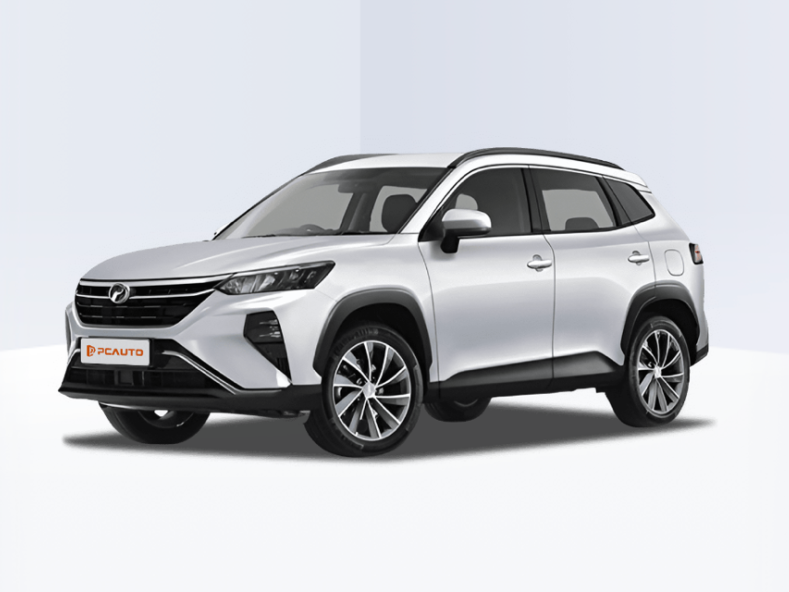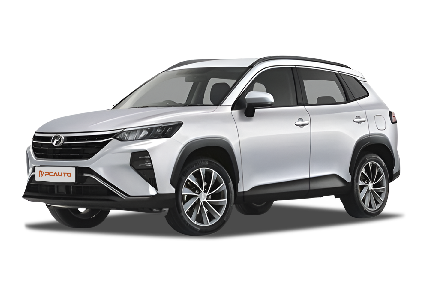Q
What is the price range of the Nexis?
The Perodua Axia is one of Malaysia's top picks for entry-level A-segment cars, and its price tag varies depending on the trim and specs you go for. For the current 2023 model, you're looking at roughly RM22,000 to RM40,000. Of course, the exact figure can shift based on the variant—like the Standard G, SE, AV, you name it—any optional extras you add, and whatever promotions are running at the time. Your best bet is to swing by a Perodua authorized dealer to get the latest quotes and check out any ongoing deals.
What makes the Axia stand out is its affordability, fuel-sipping nature, and solid value for money. It's a perfect fit for city commuting and first-time buyers. Under the hood, there's a 1.0L three-cylinder engine, paired with either a manual or automatic gearbox, and it's pretty impressive when it comes to fuel efficiency. Safety-wise, you get the basics like ABS, EBD, and dual airbags, while some higher trims up the ante with advanced features such as Vehicle Stability Control (VSC) and Hill-Start Assist (HSA).
If you're on a tight budget, the Axia is a strong contender. Not only is the initial purchase cost easy on the wallet, but maintenance fees are also relatively low. Perodua's widespread service centers and reliable after-sales network around the country only add to its appeal. Plus, the Axia holds its value well in Malaysia's used car market, making it a smart long-term choice with lower overall ownership costs.
Special Disclaimer: This content is published by users and does not represent the views or position of PCauto.
Related Q&A
Q
Which Segment Does Perodua Nexis Belong to?
The Perodua Nexis falls into the B-Segment SUV category. This vehicle is positioned slightly higher than the Axia and Bezza in Perodua's product line. It mainly targets young family users who pursue space practicality and stylish design. The body size of the Perodua Nexis is expected to be similar to that of the Proton X50, but its price will be more affordable, continuing Perodua's characteristic of high cost - effectiveness.
B - Segment SUVs are very popular in the Malaysian market. Vehicles in this category usually have a relatively high ground clearance and flexible cabin space, which are suitable for the diverse local driving environments, including urban commuting and occasional countryside trips.
The Perodua Nexis is expected to be equipped with an energy - efficient 1.5L Dual VVT - i engine and may come with advanced safety systems such as ASA 3.0, continuing the brand's tradition of emphasizing fuel economy and safety.
For Malaysian consumers, B - Segment SUVs are a popular choice that combines practicality and a sense of trend. With its mature local production and a well - established after - sales service network, Perodua can often provide solutions that better meet local needs.hts.
Q
How much engine displacement of Perodua Nexis?
The Perodua Nexis has not been officially launched yet, so the official has not announced its specific engine displacement (CC) data. However, according to industry speculation, this upcoming B-segment SUV might be equipped with the same 1.0-liter three-cylinder turbocharged engine as the Perodua Ativa. The engine has a displacement of 998cc, a maximum power of 98 horsepower, and a peak torque of 140 N·m, and is paired with a D-CVT gearbox. If the final configuration turns out to be true, this small-displacement turbocharged engine can balance fuel economy and power performance, making it very suitable for the urban road conditions in Malaysia. Meanwhile, Perodua models generally adopt a lightweight design, which further optimizes fuel consumption. It is recommended that consumers keep an eye on the latest news from the official Perodua website or authorized dealers to get accurate information. When making a purchase, Malaysian car owners can also make a horizontal comparison with engines of similar models, such as the 1.5TGDI engine (1477cc) of the Proton X50 or the 1.5L naturally aspirated engine (1498cc) of the Honda HR-V. However, they need to pay attention to the differences in road tax, insurance, and maintenance costs among engines with different displacements.
Q
What Engine is used in Perodua Nexis?
The Perodua Nexis is expected to be equipped with a 1.5-liter Dual VVT-i naturally aspirated engine. This engine shares the technical platform with models like the Perodua Ativa and Toyota Rush. It has a maximum output power of about 106 horsepower and a peak torque of 138 Nm. It is paired with a D-CVT transmission, focusing on fuel economy and smoothness in daily driving. The engine adopts a dual variable valve timing system, which can optimize the intake and exhaust efficiency at both low and high speeds and meets the EURO 4 emission standards in the Malaysian market. For Malaysian users who value practicality, this kind of small-displacement engine can balance the fuel consumption during city commuting and the occasional long-distance needs, and the maintenance cost is relatively low. It's worth mentioning that Perodua has gradually upgraded its power technology in recent years. For example, a more efficient 1.0-liter turbocharged option has been applied to models like the Bezza. In the future, it may also offer a hybrid version for the Nexis to adapt to the market trend, but the specific details shall be subject to the official release. The engine design of this kind of compact SUV usually gives priority to durability in tropical climates. It is recommended that car owners conduct regular maintenance to ensure long-term performance.
Q
What is the Gearbox Type of Perodua Nexis?
As an upcoming all-new SUV model, the official details about the transmission type of the Perodua Nexis haven't been released yet. However, based on Perodua's consistent technical approach and market positioning, it's expected to be equipped with a proven D-CVT continuously variable transmission or a 4-speed automatic transmission. These two types of transmissions have been widely used in Perodua's existing models like the Aruz and Bezza. They are particularly suitable for the urban road conditions in Malaysia, balancing fuel economy and a smooth driving experience.
It's worth noting that the D-CVT transmission offers a more direct power response by simulating gear shifts, while the traditional automatic transmission is known for its durability and low maintenance costs. Consumers can choose according to their own driving habits. If the Nexis is positioned as a youthful SUV, more advanced transmission technologies may be introduced to enhance its competitiveness. It is recommended to follow Perodua's official press conference for the final configuration information.
Malaysian consumers can refer to the actual test - drive experience when making a purchase. The transmission tuning has a significant impact on the daily driving comfort. Meanwhile, the transmissions of all Perodua models have been locally adapted to suit the tropical climate and diverse road conditions.
Q
Does Perodua Nexis Support Apple Carplay?
As a newly launched model, it hasn't been officially confirmed whether the Perodua Nexis is equipped with Apple CarPlay. It is recommended that interested consumers directly contact Perodua dealers or check the official website for the latest configuration information. Apple CarPlay is a very practical in - vehicle connectivity technology. It allows iPhone users to directly use common functions such as navigation, music, and calls through the car's infotainment screen, enhancing driving convenience and safety. In the Malaysian market, more and more new cars are starting to be equipped with this feature, especially models from Japanese and local brands. If the Nexis gets this configuration in the future, its market competitiveness will be greatly enhanced. Apart from Apple CarPlay, Android Auto is also a similar in-vehicle connectivity system, which enables Android phone users to achieve the same convenient operations. For Malaysian consumers who value the technological experience, they can pay more attention to these smart connectivity configurations when buying a new car, as they can significantly improve the daily driving experience.
Q
What is the Tyre Brand of Perodua Nexis?
As the only part of the vehicle that contacts the ground, tires are crucial for driving safety, fuel consumption performance, and noise control. It is recommended that car owners give priority to products that match the original factory specifications (such as size 195/55 R16 or similar parameters) when replacing tires in the future. Also, pay attention to the tread wear indicator lines to ensure safety. If you're after better performance, you can consider upgrading to silent or energy-saving tires after the warranty period. But be aware that modifications may affect the original factory warranty terms, so it's advisable to consult an authorized service center.
In Malaysia's rainy climate, it's particularly important to choose tire treads with strong wet-grip performance. Regularly checking tire pressure and the aging condition of the tires is also basic maintenance knowledge.
Q
Is Perodua Nexis a Good Car? Learn the Pros and Cons Here
As an upcoming all-new SUV model, the currently official information reveals that the Perodua Nexis is positioned as a B-segment urban SUV. It is expected to be powered by a combination of a 1.5L Dual VVT-i engine and a D-CVT gearbox. This market-proven powertrain has advantages in terms of fuel economy and maintenance costs, making it particularly suitable for the urban road conditions in Malaysia and consumers' demand for practicality. Judging from the released teaser images, the Nexis adopts Perodua's latest family design language. The body lines are more sporty. The interior is expected to continue the brand's layout style that emphasizes functionality and may be equipped with an advanced ASA active safety system, which is quite attractive to Malaysian family users who value safety. Although the specific configuration and price have not been announced yet, referring to Perodua's consistent market strategy, the Nexis is likely to follow the high-cost-performance route, competing differently with the Proton X50 and providing consumers with a more affordable SUV option. It is recommended that potential buyers pay attention to the upcoming detailed specifications and take a test drive to experience its space performance and handling feel. At the same time, compare the after-sales warranty policies of models in the same class. After all, a 5-year warranty period has become the mainstream standard in the Malaysian market, and Perodua's nationwide service center network is a remarkable advantage for its after-sales service.
Q
What is the Second Hand Price of Perodua Nexis? Check Used Price Here
Normally, used - car prices are affected by multiple factors such as the vehicle's age, mileage, condition, maintenance records, and market demand. Take other popular Perodua models like the Myvi or Axia as an example. The used - car prices of vehicles with a 1 - 3 - year age are approximately 60% - 80% of the original price, but the specific price depends on the configuration and market supply and demand.
If you're considering buying a used car, it is advisable to check vehicles that have undergone professional inspections through authorized dealers or certified platforms. At the same time, pay attention to checking the Service Book to confirm the maintenance history, and it is recommended to take a test drive to confirm the mechanical condition.
For models about to be launched, you can also refer to the depreciation curves of similar - positioned models of the same brand as a future reference. However, note that the application of new technologies or differences in configurations may cause price fluctuations.
Q
What is the Fuel Consumption of Perodua Nexis?
As an upcoming all-new SUV model, the official fuel consumption data of the Perodua Nexis has not been officially released yet. But referring to Perodua's consistent use of energy-saving technologies such as the DVVT dual variable valve timing system and lightweight body design, it is expected that its fuel economy will continue the brand's advantage, possibly ranging from 5.0 to 6.5 liters per 100 kilometers. The specific performance depends on the actual power configuration (such as a 1.5L naturally aspirated engine or a hybrid system) and driving conditions.
For Malaysian consumers, in the daily use scenarios of urban commuting combined with highway sections, this kind of compact SUV can usually balance power and fuel consumption. It is recommended to pay attention to the actual test data released by the subsequent PUSPAKOM certification or the Energy Efficiency Label (EEV).
It is worth mentioning that fuel consumption is significantly affected by driving habits, road conditions, and maintenance status. Regularly maintaining tire pressure and avoiding rapid acceleration and deceleration can improve fuel efficiency. And the reasonable use of air conditioning in Malaysia's hot climate is also a key factor in optimizing energy consumption.
If you have higher requirements for energy efficiency, you can compare it with models in the same class, such as the 1.5TGDI engine of the Proton X50, or wait for the technical details of Perodua's potential hybrid version.
Q
Is Perodua Nexis Worth Buying? Check out Its Features Here!
The Perodua Nexis, as an upcoming all-new SUV model, is truly worth the attention of Malaysian consumers. It is expected to be equipped with a 1.5L Dual VVT-i engine, paired with a D-CVT transmission, offering a smooth driving experience and good fuel economy, which is suitable for daily commuting and family use. Based on the known information, the Nexis might be equipped with advanced safety systems such as ASA 3.0 (Advanced Safety Assist) and six airbags, which are quite competitive among models in the same class. The interior space is expected to continue Perodua's consistent practicality. The rear seats can be folded down to increase the luggage capacity, meeting the multi - purpose needs of Malaysian families. Although the official has not yet announced the full configuration and price, referring to Perodua's high - cost - performance strategy for previous models like the Ativa and Aruz, the Nexis is very likely to continue this advantage. For consumers with a budget of around 100,000 ringgit who are looking for reliability and practicality, they might as well wait for more official information before making a decision. Given Malaysia's rainy and hot climate, it is recommended that consumers pay extra attention to the vehicle's air - conditioning cooling effect and anti - rust process when buying a car. These details can often enhance the long - term driving experience.
Popular Cars
Model Year
Car Compare
Car Photo
Latest Q&A
Q
Why is gasoline a fuel?
Gasoline can serve as a fuel because it possesses core properties suitable for providing power and the ability to convert energy. It is a hydrocarbon mixture obtained through fractional distillation and cracking of petroleum, mainly containing C5-C12 aliphatic hydrocarbons, naphthenes, and a small amount of aromatic hydrocarbons. It is characterized by volatility and flammability, with low viscosity facilitating smooth flow in injection systems, and rapid evaporation enabling quick formation of a uniform combustible mixture with air. Gasoline stores chemical energy; when ignited by a spark plug in the engine combustion chamber, it burns rapidly to release a large amount of thermal energy, which pushes the piston to move and converts into mechanical energy, providing power for vehicles such as cars and motorcycles. In addition, the anti-knock property of gasoline (measured by octane number) can adapt to engines with different compression ratios, ensuring stable operation and performance; it has a high energy density, storing more energy per unit volume, good combustion efficiency, and high availability of gas stations for convenient use. Therefore, it has become the main fuel for spark-ignition internal combustion engines and is widely used in transportation and related fields.
Q
What are 1st, 2nd, and 3rd family gases?
The first, second, and third family cars are vehicle categories classified based on the stages of family car-purchasing needs. The first family car is an entry-level economical model, such as the Perodua Axia and Proton Saga, priced at approximately 30,000 to 50,000 Malaysian ringgit. It emphasizes fuel efficiency and practicality, making it suitable for young families purchasing a car for the first time. The second family car falls into the mid-range category, offering more space and enhanced features, such as the Proton Persona and Toyota Vios, priced between 60,000 and 100,000 Malaysian ringgit, catering to the comfort requirements of growing families. The third family car is a premium model or an MPV/SUV, such as the Proton Exora and Honda CR-V, priced above 100,000 Malaysian ringgit. It boasts spacious interiors and upscale configurations, ideal for larger families or long-distance travel. Malaysian consumers typically prioritize fuel efficiency, maintenance costs, and space when selecting a vehicle. Families at different life stages adjust their car choices accordingly. For instance, small families may begin with the first category, upgrade to the second after having children, and larger families often opt for the third category.
Q
What are the four types of natural gas?
Natural gas can be classified into four main types based on its source: gas field gas (pure natural gas), associated petroleum gas, condensate field gas, and coalbed methane. Gas field gas is directly extracted from gas wells, typically containing over 90% methane with minimal impurities. Associated petroleum gas is a byproduct of oil extraction, containing not only methane but also significant amounts of other hydrocarbons such as ethane and propane. Condensate field gas yields light hydrocarbon fractions during extraction, characterized by a high methane content and small quantities of heavier hydrocarbons like pentane. Coalbed methane is extracted from underground coal seams, primarily consisting of methane and nitrogen, and must have a methane content exceeding 40% to be utilized as fuel. Due to compositional differences, these natural gas types vary in calorific value and applications. The first three are commonly used for urban gas supply, whereas coalbed methane requires purification before effective utilization. As a clean and efficient energy source, the development and utilization of these diverse natural gas types play a crucial role in optimizing energy structure.
Q
What are the three types of fuel gas?
Common fuel gases are mainly divided into three types: natural gas, liquefied petroleum gas (LPG), and manufactured gas. Natural gas is a flammable gas existing in nature, with methane as its main component. It is colorless and odorless, leaves no residue after combustion, and has high thermal efficiency, making it a clean energy source. Liquefied petroleum gas is a by-product of the petroleum refining process, whose main components include propane and butane. It is a gas at room temperature but can be converted into liquid through pressurization and cooling, facilitating storage and transportation. Manufactured gas is generated through thermochemical reactions of fossil fuels such as coal or petroleum under specific conditions, with main components including hydrogen, carbon monoxide, and methane. It has low production costs but produces certain pollution after combustion, so ventilation should be ensured during use. These three fuel gases have different application scenarios in the energy supply field, and their calorific values and usage characteristics also vary. For example, the calorific value of natural gas is approximately 33,000-36,000 kcal per cubic meter, that of LPG is about 90,000 kcal per kilogram, and that of manufactured gas is roughly 3,500-4,200 kcal per cubic meter. The different calorific values make them suitable for different energy demand scenarios such as households and industries.
Q
Is unleaded petrol a gas?
Unleaded gasoline is not a gas but a liquid fuel. It refers to gasoline with a lead content of less than 0.013 grams per liter and without the addition of tetraethyl lead as an anti-knock additive during the refining process. Its octane rating is typically 95, slightly lower than the 97 of leaded gasoline. The use of unleaded gasoline can effectively reduce emissions of harmful substances such as hydrocarbons, carbon monoxide, and nitrogen oxides in vehicle exhaust, thereby lowering pollution risks including smog, toxic gases, and acid rain. However, it should be noted that while unleaded gasoline contains no artificially added lead, it still retains trace amounts of lead from crude oil. Additionally, its combustion releases gases, particulate matter, and condensates, with particles smaller than 2 microns in diameter being particularly prone to prolonged suspension in the air and subsequent human inhalation. Thus, potential health impacts remain a concern. Currently, most vehicles can use unleaded gasoline directly, though certain models require selecting the appropriate octane grade as recommended by the manufacturer to ensure optimal engine performance and longevity.
View MoreRelated News

Perodua Nexis / Traz (D66B) how much will it sell for?
RobertDec 17, 2025

Perodua D66B teaser revealed, a new B-segment SUV based on the Yaris Cross is coming soon
WilliamDec 10, 2025

Should I choose Proton X50, or continue waiting for the repeatedly disappointing Perodua Nexis?
JohnNov 22, 2024

Will Perodua Nexis (D66B) Compete with Proton X50?
LienJun 19, 2024

Perodua Myvi and Bezza may undergo major upgrades in 2026
LienDec 24, 2025
View More


















Pros
Cons